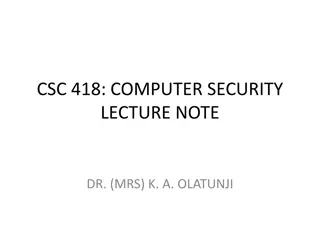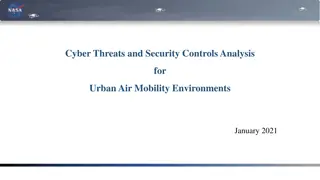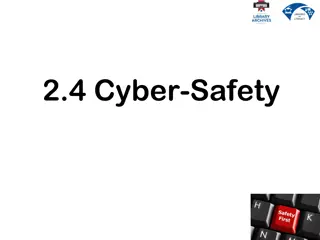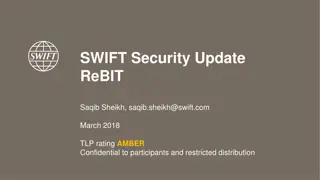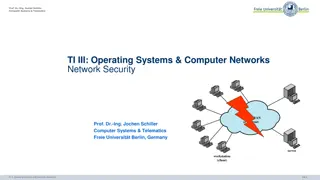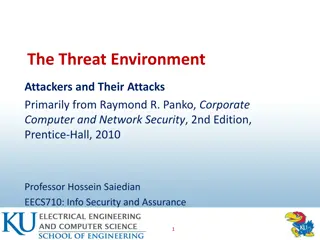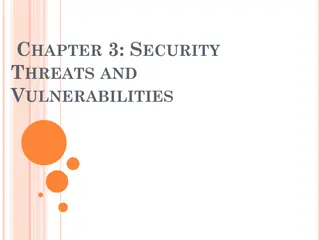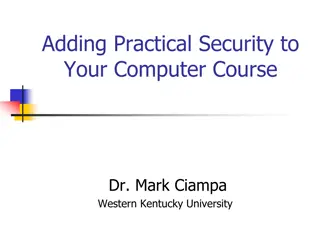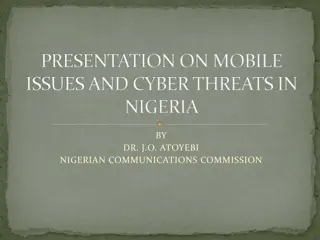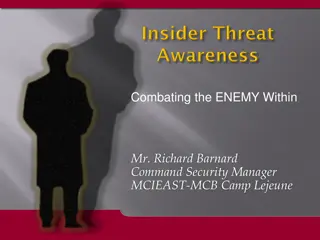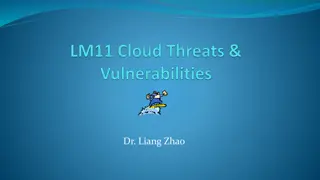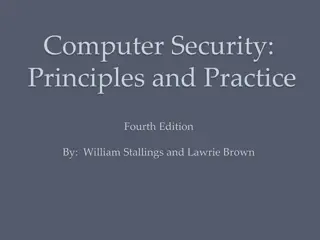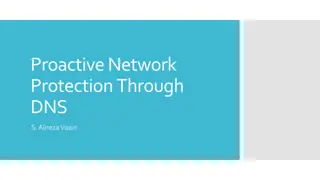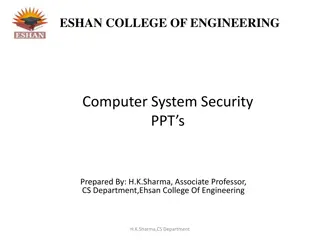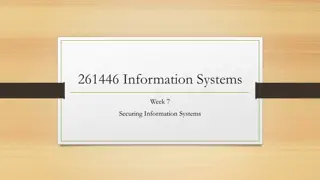Understanding Computer Threats and Security Measures
Computer threats are constantly evolving, posing risks such as unauthorized access, data manipulation, and cyber-attacks. This chapter discusses various types of threats to users, hardware, and data security measures to mitigate these risks. Learn about identity theft, malware, cyber terrorism, and other potential dangers that can compromise computer systems.
Download Presentation

Please find below an Image/Link to download the presentation.
The content on the website is provided AS IS for your information and personal use only. It may not be sold, licensed, or shared on other websites without obtaining consent from the author. Download presentation by click this link. If you encounter any issues during the download, it is possible that the publisher has removed the file from their server.
E N D
Presentation Transcript
Computer Threats & Basic Security Measures .
Learning Objectives In this chapter you will learn about: Basic Concept ofThreat Types ofThreats Threats to the User Threats to Hardware Threats to Data Security Measures forThreats
Threats Computer security threats are constantly evolving. These threats are masters of disguise and deception, always evolving new ways to irritate,steal,and harm. A threat is any scenario or occurrence that has the potential to harm unauthorized access, destruction, disclosure, data manipulation,and/or denial of service. Basically, a computer threat is a term that relates to the security of a compromised. This is possible dangers that can affect the smooth functioning of a computer. This threat can lead to cyber-attacks and data being stolen, lost, or manipulated. irreparable in some cases. the computer through computer system being Damage can be
Threats A computer threat can be "intentional" such as hacking or "accidental" such as malfunctioning or physical damage. If a user can gauge the degree of harm that different threats can cause, they can prioritize them and take countermeasures. Regularly backing up countermeasure against the treat of data loss. A firewall is a countermeasure against hackers. In the present age, computer security threats are constantly increasing as the world is going digital. users data is a
Types of Threats Computer threats can be classified into: Threat to the User Identity Theft Loss of Privacy Computer Related Injuries Online Spying Tools Email Spam Threat to Hardware Power Related Threats Theft and Vandalism Natural Disasters Threat to Data Malware, Viruses and Malicious Programs Cybercrime Cyber Terrorism
Threat to the User Identity Theft Identity theft is a form of crime in which someone s personal information is used without permission. Public profiles on social networks or other popular online services can be used as the source of data, helping criminals to impersonate their targets. Affected individuals can suffer financial loss due to unauthorized withdrawals and purchases made in their names. However, identity theft can also be done to damage the victim s reputation.
Threat to the User Methods of Obtaining Information Criminals obtain information by using various methods, such as; Shoulder Surfing; Shoulder surfing means watching someone while entering personal ID information for a private transaction. Snagging; A thief can try to snag information by listening through a telephone extension, through a wiretap while the victim gives credit card information to a legitimate agent. Dumpster Diving; Dumpster diving is looking for treasure in someone else's trash. In the world of information technology (IT), dumpster diving is a technique used to retrieve information that could be used to carry out an attack or gain access to a computer network from disposed items. Social Engineering; Social engineering is the art of manipulating people so they give up confidential information such as passwords or bank information by disguising as something legitimate. High Tech Methods; The ID thieves can get information using a computer and Internet connection. A person s identity may be snagged from unsecured internet sites.
Threat to the User Loss of Privacy People information while transactions and that information are being generated and reaching the hands of other parties. Thus, privacy could be lost. Social media records that are open to the public are another way of losing privacy. are disclosing their personal
Threat to the User Computer Related Injuries Computer use can cause physical injuries to the user. Prolonged mouse staring at a monitor for long time, and poor seating conditions are the primary cause of such injuries. It can cause especially eyesight problem and other health related problems. and keyboard use,
Threat to the User Online Spying Tools Software developers have created a number of ways to track user s online activities using internet. Many of these tools, which may pose a threat to users,are discussed further below; Cookies Cookies are regarded as a significant threat to privacy, despite their beneficial purpose. This is because they can be used to store and report many types of information, like user online activity history, visited sites, passwords, etc. Later, these can be used against the user s wishes. Web Bugs A web bug can record what pages user view,key words user type into a search engine, personal information user enter in a form on a web page, and other data. Because Web bugs are hidden, they are considered by many to be eavesdropping devices.
Threat to the User Spyware Spyware is installed on a computer without the user s knowledge and collects information without the user's consent. Spyware can record individual keystrokes,Web usage,e-mail addresses, personal information, and other types of data. Besides, spyware can also refer to legitimate software that monitors your data for commercial purposes like advertising. However, malicious spyware is explicitly used to profit from stolen data.
Threat to the User Email Spam Email spam, also referred to as junk email or simply spam, is unsolicited messages sent in bulk by email. Most email spam messages are commercial in nature. Whether commercial or not, many are not only annoying as a form of attention theft,but also dangerous because they may contain to phishing web sites hosting malware or include malware as file attachments. Spammers collect email addresses from chat rooms, websites, customer lists, newsgroups, and viruses that harvest users' address books. These collected email addresses are sometimes also sold to other spammers. links sites that that lead are or
Threats to Hardware Power Related Threats Power problems affect computer in two ways: Power fluctuations, when the strength of your electrical service rises component failures. Power failure, when power is lost altogether, causes systems to shut down. Both power failures and fluctuations can result in a loss of data. Uninterruptible Power Supplies countermeasure to this threat. or falls, can cause (UPS) can be a
Threats to Hardware Theft and Vandalism Thieves can steal the entire computer or cause hardware vandalism, which is the act of intentionally or unintentionally breaking or destroying computer hardware. In both cases, the system and the data stored were completely destroyed. Keep the PC in a secure area, lock the computer to a desk, do not eat near the computer, handle equipment with care, etc. can be countermeasures to this theft and vandalism.
Threats to Hardware Natural Disasters Disaster may be natural and manmade. This disaster could result in a total loss. Natural disaster (flood, fire, and earthquake) is difficult to protect. Because disasters vary by location. User has to take preparation and have to be aware about the natural disaster. User can take steps to protect his/her computer from manmade disasters. natural
Threats to Data Malware, Viruses and Malicious Programs The term malware describes viruses, worms, Trojan horses etc. These virulent programs represent the most common threat to user s information. Viruses are pieces of a computer program that attach themselves to host programs. Worms are particular to networks, spreading to other machines on any network you are connected to and carrying out preprogrammed attacks on the computers. Trojan horses, like their malicious code under the guise of a useful program namesake, introduce
Threats to Data Cybercrime The use of a computer to carry out any conventional criminal act, such as fraud, is called cybercrime and is a growing menace. Cybercrime is growing so rapidly, in fact, that the federal government has created a handful of agencies to deal with computer related crimes. Hacking remains the most common form of cybercrime and it continues to grow in popularity. A hacker is someone who uses a computer and network or internet connection to intrude into another computer or system to perform an illegal act. At one time, a hacker was just a person who understood computers well; however, hacking now refers to criminal or antisocial activity.
Threats to Data CyberTerrorism Cyber warfare and cyber terrorism are new forms of warfare; they information infrastructure of the nation. The conventional goal in the case of cyber terrorism is to harm or control key computer systems,or digital controls. It is done to accomplish an indicator aim such as to disrupt a power grid or telecommunications. Typical targets are power plants, nuclear facilities, water treatment plants,and government agencies. attack the critical
Security Measures The basic security measures for various threats are; Use Strong Passwords Use Password Manager Limit & Control Access to Critical Data Put Up a Firewall Use Security Software Update Programs and Systems Regularly Secure the Portable Devices Secure Wi-Fi Network Monitor for Intrusion Schedule Backups Be Smart with Emails and Surfing the Web Turn Off Computer and Disconnect from the Internet Raise Awareness




